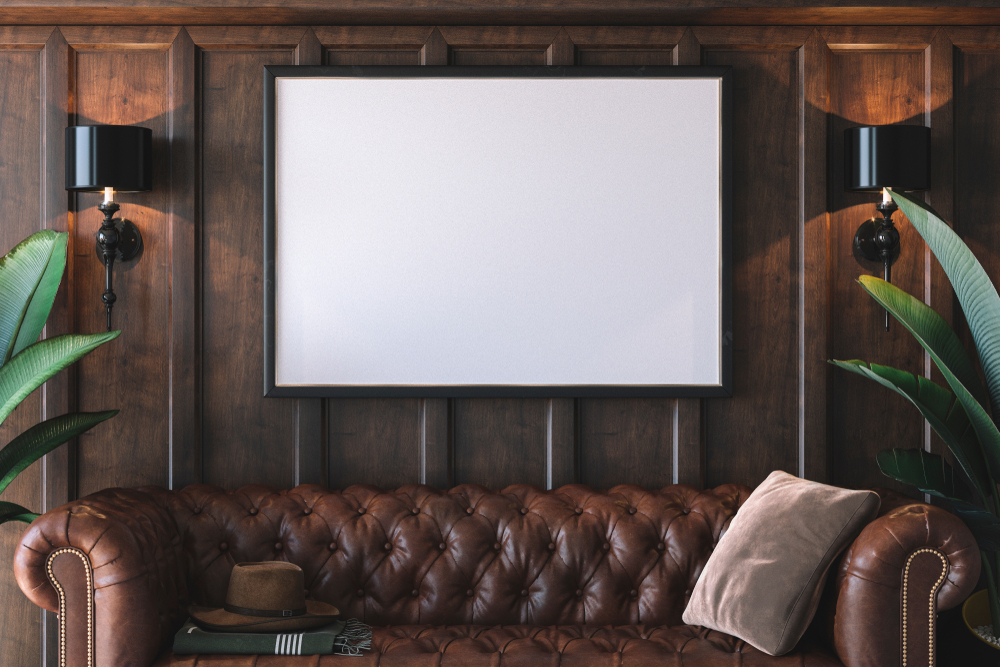Basics of Canvas Framing: How to Pick Right Frame

Choosing the ideal frame for your canvas artwork is as important as selecting the artwork itself. A mismatched frame can make even the most stunning piece of art appear awkward or out of place.
On the other hand, the right frame can enhance the beauty of your artwork and safeguard its value.
In this guide, we’ll walk you through the basics of Canvas framing your canvas art with ease. Let’s make your art canvas look its best!
Why Canvas Framing Matters | 3 Key Benefits
Canvas framing is simply putting your canvas artwork onto a frame. It keeps your art safe and makes it look nicer. It’s like giving your artwork a cozy home to stay in.
It offers several advantages:
- Longevity: It helps your artwork last longer.
- Protection: It shields your artwork from dirt, dust, and damage.
- Professional Look: It adds to the appearance of your artwork, giving it a polished and professional look.
Canvas framing includes stretching and securely attaching canvas artwork to a frame. This not only safeguards the artwork but also provides a means to showcase it in your home or office.
2 Types Of Canvas Frames
Two primary types of canvas frames exist: gallery-style and floater-style.
Type #1: Gallery-Style Frames
Gallery-Style Frames are the go-to choice for canvas art. Comprising side rails, a top rail, and a backboard. They provide a classic and secure display.
These frames give your art canvas a timeless and classy appearance that works well with any style. The side and top rails ensure your artwork stays firmly in place. The backboard adds extra protection and stability, keeping the canvas safe from damage.
Whether it’s a family photo or a modern piece of art. These frames provide a stylish and dependable option for proudly displaying your artwork.
Type #2: Floater-Style Frames
Floater-style frames offer a modern twist, lacking a backboard and giving the illusion of the artwork “floating” within the frame. This effect is achieved by custom canvas stretching over a spacer bar.
These frames offer a sleek and minimalist look that complements modern decor styles. By eliminating the backboard, they allow the artwork to stand out on its own, drawing attention to its beauty and depth.
Whether it’s a vibrant abstract painting or a serene landscape. These frames provide a modern and stylish option for displaying your art with sophistication.
How To Choose the Right Canvas Frame? | 3 Easy Steps
When it comes to picking a frame for your canvas art, keep these tips in mind:
Step #1: Choose Frame that Matches Your Artwork Style
Think about the style of your artwork.
- For modern pieces, go for frames with clean lines.
- For traditional art, consider ornate frames that match the classic vibe.
Here’s how to match the frame to your art:
- Canvas Frame for Modern Art: If your artwork features clean lines, bold colours, and minimalist design, go for frames with simple, sleek profiles. Think of black or metallic frames with straight edges. These frames complement the contemporary look and allow the artwork to take centre stage.
- Canvas Frame for Traditional Art: For artwork with a more classic or traditional vibe, consider frames with ornate details. These decorative frames add an elegant touch that complements the timeless appeal of the art.
Step #2: Pick the Right Colour
When it comes to picking the colour for your frame. It’s important to choose one that works well with your artwork without stealing the spotlight.
Make sure the frame colour goes well with the colours and style of your artwork. You want it to enhance the art, not overpower it. If you’re not sure which colour to choose, black is a safe option. It usually goes well with most artworks.
Here’s some practical advice to help you choose the best frame colour for your artwork:
1. Make Your Artwork Stand Out
Consider the dominant colours in your artwork and choose a frame colour that complements them.
For example, if your artwork features warm tones like reds and oranges, a wooden frame complements it nicely.
2. Black Frames Are Classic & Fits Everywhere
Black frames are indeed versatile. But be mindful of the overall mood you want to create.
They work well in modern and minimalist settings. But are not the best choice for lighter or more whimsical pieces.
3. Experiment with Different Colours
Experiment with different frame colours to see which one brings out the best in your artwork.
Don’t forget to consider the colours of your walls and the room’s decor to ensure the frame complements the space as a whole.
4. Test Them Out
Before making a final decision, take advantage of mock-up tools or physically place different coloured frames around your artwork to see how they look in the space.
This hands-on approach can help you visualize the final result and make a confident decision.
Step #3: Pick Correct Size for Your Frame
Make sure the frame is the right size for your artwork. It should be proportional to the piece to avoid it looking awkward or overwhelming.
Here are some practical tips to ensure your frame fits your artwork perfectly:
1. Measure Carefully
Use a ruler or tape measure to get precise measurements of your artwork’s width, height, and depth. This ensures you choose a frame that fits like a glove.
2. Allow for Breathing Room
When selecting a frame size, aim for a slight overlap of the frame around the edges of your artwork. This prevents any part of your art from being covered up and gives it room to breathe.
3. Match the Size to Surrounding Space
Think about where you’ll be displaying your artwork.
- If it’s in a small room, a large frame might overwhelm the space.
- On the other hand, a small frame might get lost in a large room.
Choose a size that balances well with the surrounding environment.
4. Visualize the Final Look
Before making a final decision.
“Use paper or cardboard cutouts to imitate the size of the frame around your artwork.”
This allows you to visualize how the finished piece will look and make any necessary adjustments before purchasing the frame.
DIY Canvas Framing Tutorial | 5 Easy Steps
Follow these simple guidelines for framing your artwork:
Step 1 || Prepare Your Workspace
Clear a flat area large enough for the frame and canvas. Lay down a clean cloth to protect the artwork.
Step 2 || Position the Canvas
Place the canvas face down on the cloth and centre the frame over it.
Step 3 || Secure the Canvas
If you’re using a traditional frame, you need to attach the canvas to the stretcher bars first. Then, fit the canvas and stretcher into the frame. Ensure it’s tightly placed against the rabbet.
Step 4 || Fixing the Canvas
Use points or small nails to secure the stretcher bars in place within the frame.
Step 5 || Final Touches
Attach hanging hardware to the back of the frame if needed. Also, consider adding protective backing paper.
3 Tips for Gallery-Worthy Professional Finish
Here are 3 simple tips to make your framing look super professional like it belongs in a gallery:
Tip 1: Invest in Quality Materials: Don’t skimp on the frame. Better materials mean your artwork looks better and lasts longer.
Tip 2: Use the Right Tools: Grab tools like a point driver to make attaching the canvas to the frame a breeze and super accurate.
Tip 3: Mind the Details: Little things matter, like making sure your hanging hardware is all lined up perfectly. It can totally change how your artwork looks in the end.
DIY Canvas Artwork Framing | 4 Expert Tips
Are you DIY framing your canvas artwork? Here’s what you need to keep in mind:
1. Gather Your Tools: Make sure you have all the necessary tools handy:
- Measuring tape,
- Hammer,
- Level,
- Nails,
- Saw.
2. Measure and Cut: Carefully measure your artwork and cut the frame pieces to the right size. Use a level to ensure the frame stays straight.
3. Assemble the Frame: Attach the side rails to the top and bottom of your artwork. Then connect the top rail to the side rails. Secure the backboard in place to finish assembling the frame.
4. For Floater-Style Frames: Follow the same steps. But instead of a backboard, stretch the artwork over the spacer bar and secure it. Then, insert the spacer bar into the frame.
Bonus Tips
Consider these additional tips for framing canvas artwork:
- Preparation is Key: Make sure your canvas is tightly stretched and trimmed before framing.
- Accuracy Counts: Measure carefully, especially for stretched canvas, to get a snug fit.
- Protective Measures: Add a barrier between canvas boards and frames to protect your artwork over time.
- UV-Protection to Prevent Fading: If you’ve used acrylic paint, opt for UV-resistant glass or plexiglass to prevent fading.
With these simple but crucial tips, you’ll create a beautiful frame that not only complements your artwork but also keeps it safe for years to come.
3 Common Problems & Solutions of Canvas Framing
Framing isn’t always smooth sailing. Here are common hurdles and how to leap over them:
Problem #1: Misalignment
Problem: You’ve carefully placed your canvas in the frame. Only to find it’s off-centre and wonky. It’s like trying to fit a square peg into a round hole.
Solution: Take a close look at your canvas and frame setup.
Is it perfectly aligned?
If not, don’t panic. Grab a measuring tape or ruler and check for symmetry. Adjust the canvas until it sits snugly in the frame’s centre. Once aligned, secure it firmly in place.
Remember, precision is key here!
Problem #2: Frame Warping
Problem: Your once neat frame now looks more like a wavy noodle than a straight line. This bending messes up how nice your canvas looks, and it makes it wobbly and insecure.
Solution: Get rid of weak frames! Choose strong materials that last. Pick hardwood or metal frames with sturdy corners. They keep your canvas in great shape and prevent it from bending.
Problem #3: Damaged Corners
Problem: Uh-oh! Your frame’s corners, once sharp and neat, now have ugly chips and cracks. It’s enough to make any art lover cringe.
Solution: Handle with care. When putting the frame on your canvas, treat it like breakable glass.
Don’t be rough or use too much force. Secure each corner gently to keep it snug without breaking anything. If you see any cracks or chips, stop and rethink.
Sometimes, being gentle is all you need to keep those corners looking good for a long time.
Remember, Rome wasn’t framed in a day! Take your time, stay calm, and tackle each obstacle with patience and precision.
You’ve got this!
Frame it Right
In conclusion, by following these simple tips, you can take your artist canvas framing skills to the next level.
Invest in quality materials, use the right tools, and pay attention to the details. With practice and attention to detail, you’ll soon be creating professional-looking frames that are ready to be showcased in any gallery.
Keep honing your skills, and don’t be afraid to get creative!
Protect Your Art | Custom Canvas Framing by Framous Pictures
Ready to give your artwork the spotlight it deserves?
Custom canvas framing from Framous Pictures ensures your artwork looks amazing and lasts a lifetime. With personalized options and expert craftsmanship, your art gets the attention it deserves.
- Posted In:
- Informative



Leave a Reply